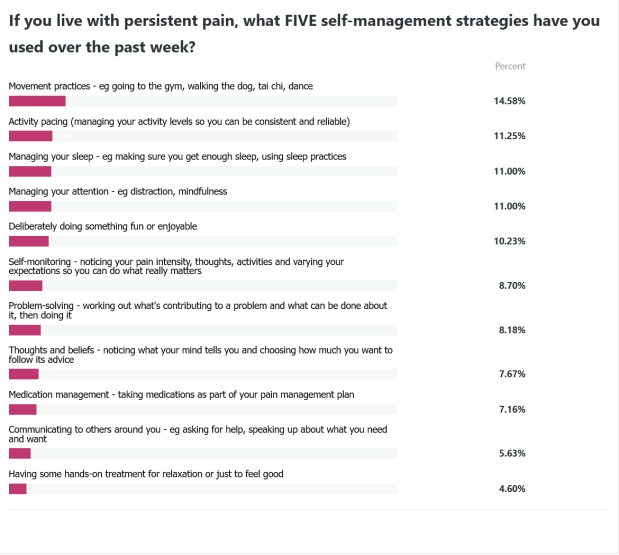I was just a tiny bit surprised when I looked at the results of my self-management strategy survey: self monitoring was smack bang in the middle of the list! Take a look yourself –

Self monitoring is not something we discuss much in pain management circles. It’s like ‘Oooh if you keep noticing your pain you’re fixating on it and that’s bad!’ and yet I suspect it forms part of the background interoceptive awareness that most of us do whether we live with pain or not.
Let’s take a deeper look at it.
The ‘definition’ I used was ‘noticing your pain intensity, thoughts, activities and varying your expectations so you can do what really matters’ – in other words, being aware of how you’re feeling (noticing) and making deliberate decisions about where to spend your energy/time.
Interoception is a fundamental process in body awareness and homeostasis. Quigley and colleagues (2021) describe a function of interoception as ‘signaling about the body’s energy status, which then drives the behaviours needed to renew energy resources’ (Quigley, et al., 2021). Philosophical questions about assumed functions aside, the term is used to refer to ‘the overall process of how the nervous system (central and automatic) sense, interprets, and integrates signals originating from within the body, providing a moment-by-moment mapping of the body’s internal landscape across conscious and unconscious levels’ (Berntson & Khalsa, 2021). In other words, this system (process?) gives us information on what is happening in the body that we then respond to either with involuntary/below conscious awareness responses, or voluntary/consciously aware behaviour. By knowing about the internal body state we can be guided to rest, eat, be active, be afraid, be curious, explore or withdraw and hide.
We would think, then, that because this system/process aids our survival, we’d be pretty tuned to what’s going on and act accordingly. BUT if you’ve ever found yourself watching an engrossing movie, or been out with friends, knowing you need to pee but just not going – you know that feeling the feels doesn’t always mean doing the doing! And for people who have particular jobs (the Beefeaters, bakers, pilots, models….) where the urge to deal with body sensations must be suppressed because [reasons], the ability to over-ride body sensations and focus on the task is critical. In fact, kids in school need to learn when it’s OK to pee, eat or wriggle – and it’s those kids who have a hard time developing social skills (ADHD, ASD etc) that often raise the ire of teachers.
So, we learn what our normal ‘body states’ are and develop strategies to periodically over-ride the initial urge to do something in response in order to live in a social world.
For people living with something like widespread body pain (aka fibromyalgia) one of the challenges is that our bodies are ‘over-sensitive’ – so sitting for me is not my favourite thing, at least, not without wriggling a lot. In one sense, my interoception is a little over-jigged, while part of me wonders whether in learning how not to ‘over-react‘ I’ve maybe learned to be a bit insensitive. Di Lernia et al (2016) conducted a systematic review that found that people with chronic pain might have low accuracy for things like noticing their heart rate, and the labeling of those interoceptive experiences might not be terribly accurate. The challenge is studying these processes without confounding the findings with after-the-fact beliefs or justifications (see below).
But interoception is also about hunger and satiety – and we’re moving into Christmas, so there are all those cues to eat and drink foods we wouldn’t normally have and in quantities we wouldn’t normally eat. Tied in with this is memory (ever felt hungry around dinner time even thought you ate a large lunch?) and emotions. One theorist argues that emotions are ‘interoceptive sense data that are categorised in a specific situation using an emotion concept’ (Quigley et al., 2021; Seth, 2013). In other words, we experience our ‘self’ as an organism with a ‘this is how my body feels’ in various contexts based on integrated predictions from past experiences that in turn help us decide what to do and how we feel. In part, our thoughts might emerge out of these interoceptive senses almost as cognitive justifications or explanations after the fact.
Where does all this lead us when it comes to self-management? Well, one thing we all might benefit from remembering is that interoception, like all our sensory and perceptual apparatus, likely varies across individuals. Some of us are probably more sensitive and aware of how ‘we’ feel, while others might be less so. The effect of pain that persists might influence the attention a person places on both that area of the body – and perhaps other areas of the body too (internal or external). Maybe by attending mindfully to how ‘we’ feel (internally and externally), people with pain can be less likely to over-focus or ignore sensory experiences. Some researchers are stimulating C-fibres at a particular frequency and pressure, to help reduce pain (Di Lernia et al., 2020), arguing that by amplifying the interoception a person’s system receives, they can develop a less reactive (ie reduced pain) response.
What I can say is that there are many anecdotes and a few reasonable studies showing that by learning to attend to (notice) the body and titrating activity levels accordingly people can allocate their energy to where they want to. It’s a kind of ‘pacing’ (but this is a vexed term, and more on this another time!) – and means that instead of pushing really hard to maintain the one level of activity, people can maintain a more flexible level of doing by acknowledging that sometimes we are simply tired, and need a break. In this instance please note I’m not talking about the ‘rehabilitation’ phase of therapy where increasing the amount a person can consistently manage is often the focus – what I’m talking about is the lifelong approach to managing activity, energy, emotions and daily doing that happens after rehabilitation is done and dusted.
You see, the thing is that people living with pain have lives. Lives aren’t the same from day to day, year after year. People do catch colds, grieve, celebrate, get enthused about something then decide it’s not going to be a long-term part of their world. We are always developing and evolving – noticing how we feel and our energy/emotions/thoughts can help us make decisions about what to prioritise in a day or a week. Focusing on pain to the exclusion of noticing anything else in life is probably not going to help you live life. Failing to notice what your pain is up to is equally likely not to help you live life. The former is ‘hypervigilance’ while the latter is a lot like ‘gritted determination.’ For me coming up to Christmas, I’m taking some time to notice my fatigue is a bit more than I’d like (and some random achey bits doing their thing too) so I’m not going to go leaping into Christmas shopping at the mall. I’m planning on a quiet internet shop so I don’t have to and I can instead spend my energy on making my home feel lovely and inviting. Flexibly persisting means being more like water than a wall.
Berntson, G. G., & Khalsa, S. S. (2021). Neural Circuits of Interoception. Trends Neurosci, 44(1), 17-28. https://doi.org/10.1016/j.tins.2020.09.011
Di Lernia, D., Lacerenza, M., Ainley, V., & Riva, G. (2020). Altered Interoceptive Perception and the Effects of Interoceptive Analgesia in Musculoskeletal, Primary, and Neuropathic Chronic Pain Conditions. J Pers Med, 10(4). https://doi.org/10.3390/jpm10040201
Di Lernia, D., Serino, S., & Riva, G. (2016). Pain in the body. Altered interoception in chronic pain conditions: A systematic review. Neurosci Biobehav Rev, 71, 328-341. https://doi.org/10.1016/j.neubiorev.2016.09.015
Quigley, K. S., Kanoski, S., Grill, W. M., Barrett, L. F., & Tsakiris, M. (2021). Functions of Interoception: From Energy Regulation to Experience of the Self. Trends Neurosci, 44(1), 29-38. https://doi.org/10.1016/j.tins.2020.09.008
Seth, A. K. (2013). Interoceptive inference, emotion, and the embodied self. Trends in Cognitive Sciences, 17(11), 565-573. https://doi.org/10.1016/j.tics.2013.09.007

Very insightful writing as usual!
I just wonder about the use of the word ‘deserve’ in the context of taking a break…to me it suggests a condition of having achieved something worthy before allowing oneself to do so.
Good point Lou, ‘need’ or ‘require’ might be a better term! Simply being is worthy of course, but somehow we don’t take that on board so easily right?!